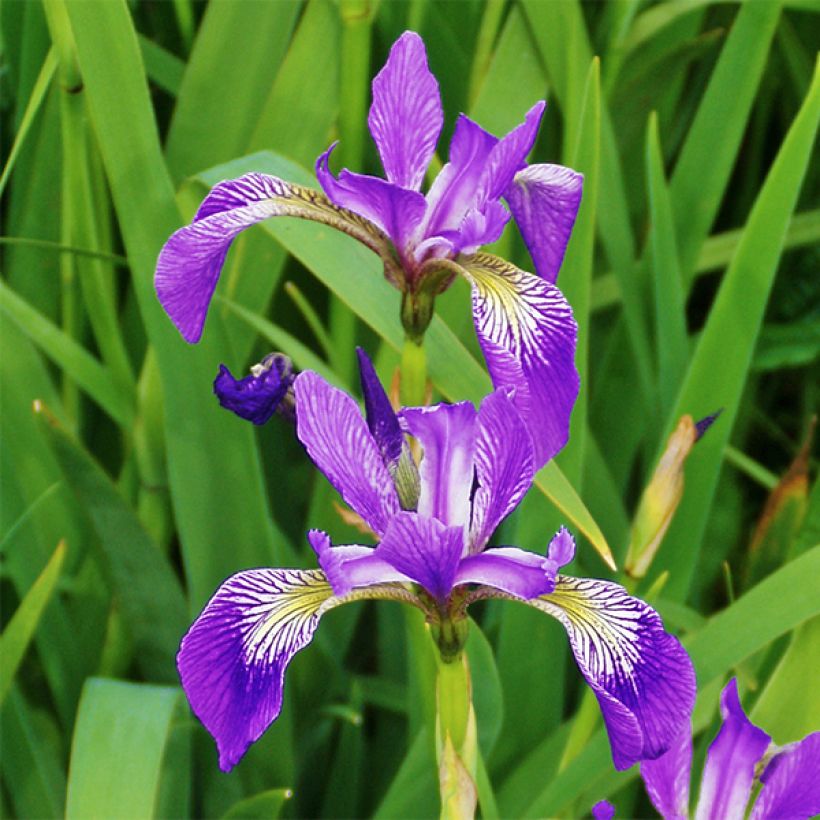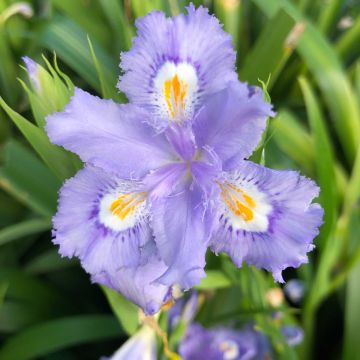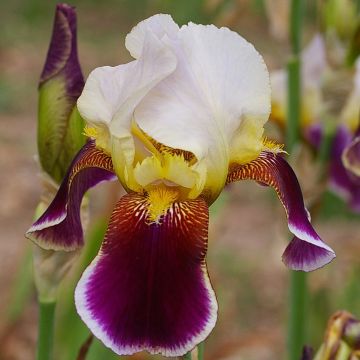

Iris versicolor Kermesina - Water Iris
Iris versicolor Kermesina - Water Iris
Iris versicolor Kermesina
Blue Flag, Boston Iris
This item cannot be shipped to the selected country
Delivery charge from €5.90
More information
Schedule delivery date,
and select date in basket
This plant carries a 12 months recovery warranty
More information
We guarantee the quality of our plants for a full growing cycle, and will replace at our expense any plant that fails to recover under normal climatic and planting conditions.
From €5.90 for pickup delivery and €6.90 for home delivery
Express home delivery from €8.90.
Does this plant fit my garden?
Set up your Plantfit profile →
Description
Iris versicolor 'Kermesina' is a perennial rhizomatous plant for wet areas with intriguing flowering, textured with white.
Belonging to the large Iridaceae family, the type variety is native to the large wet plains and marshes of North America. It is common in carex meadows, swamps, and along riverbanks. It is also one of the few native species that can be cultivated without difficulty. In spring, the deciduous ensiform (sword-shaped) leaves grow to a width of 2.5cm (1in), followed very quickly by the flowering. This flowering occurs from May to July, with 5 to 6 velvety-textured flowers per stem, reaching a height of 60cm (24in). Petals, sepals, and styles are delicately reticulated with a plum colour and white. The sepals are scalloped with yellow-green at their base. Narrow and horizontal at the base, they suddenly widen into a triangular, elegantly curved section. The flowers are medium-sized, approximately 10cm (4in) in width. They have a very light powdery fragrance typical of irises, but less pronounced than in their counterparts.
Iris versicolor 'Kermesina' thrives in full sun or partial shade. As a pond plant, it will reach its full potential with its feet in 5 to 10cm (2 to 4in) of permanent water. Unlike I. germanica, which does not like excess water, this one particularly seeks it. In any case, it is one of the species best adapted to cultivation in wet and humus-rich soils. It is very easy to cultivate and, once established, is very hardy and requires little maintenance. The plants need two years before the first flowering, but the highly cut-out silhouette of its inflorescences and its wild freshness are well worth the wait. Afterwards, the rhizomes can be divided every three years. At the end of flowering, cut back the stems. You can reintroduce it to its natural environment. I. versicolor can be found in carex meadows. You can vary the colours and shades of the different varieties of this grass. On the edge of a pond, consider planting with other water irises, such as I. pseudacorus, I. chrysographes 'Black Knight', and then introduce concentric circles of purple or pearly astilbes, Provence canes, and bearded irises. They all love pond edges.
Everything refers to colour in the denomination of the 'Kermesina' variety. In Greek mythology, Iris was the messenger between Earth and the gods of Olympus. Today, with more than 200 varieties in a wide spectrum of colours, the iris proudly bears the name that designates the rainbow in Greek. Closer to us, I. versicolor designates a plant whose colours fluctuate. 'Kermesina' simply means crimson or violet with a hint of red, and describes plant varieties whose flowers have this colour.
Report an error about the product description
Iris versicolor Kermesina - Water Iris in pictures




Flowering
Foliage
Plant habit
Botanical data
Iris
versicolor
Kermesina
Iridaceae
Blue Flag, Boston Iris
North America
Other Iris A to Z
Planting and care
Although growing in marshes, waterlogged meadows or even with its feet in the water, this iris thrives well in slightly moist garden soil.
Planting period
Intended location
Care
-
, onOrder confirmed
Reply from on Promesse de fleurs
Haven't found what you were looking for?
Hardiness is the lowest winter temperature a plant can endure without suffering serious damage or even dying. However, hardiness is affected by location (a sheltered area, such as a patio), protection (winter cover) and soil type (hardiness is improved by well-drained soil).

Photo Sharing Terms & Conditions
In order to encourage gardeners to interact and share their experiences, Promesse de fleurs offers various media enabling content to be uploaded onto its Site - in particular via the ‘Photo sharing’ module.
The User agrees to refrain from:
- Posting any content that is illegal, prejudicial, insulting, racist, inciteful to hatred, revisionist, contrary to public decency, that infringes on privacy or on the privacy rights of third parties, in particular the publicity rights of persons and goods, intellectual property rights, or the right to privacy.
- Submitting content on behalf of a third party;
- Impersonate the identity of a third party and/or publish any personal information about a third party;
In general, the User undertakes to refrain from any unethical behaviour.
All Content (in particular text, comments, files, images, photos, videos, creative works, etc.), which may be subject to property or intellectual property rights, image or other private rights, shall remain the property of the User, subject to the limited rights granted by the terms of the licence granted by Promesse de fleurs as stated below. Users are at liberty to publish or not to publish such Content on the Site, notably via the ‘Photo Sharing’ facility, and accept that this Content shall be made public and freely accessible, notably on the Internet.
Users further acknowledge, undertake to have ,and guarantee that they hold all necessary rights and permissions to publish such material on the Site, in particular with regard to the legislation in force pertaining to any privacy, property, intellectual property, image, or contractual rights, or rights of any other nature. By publishing such Content on the Site, Users acknowledge accepting full liability as publishers of the Content within the meaning of the law, and grant Promesse de fleurs, free of charge, an inclusive, worldwide licence for the said Content for the entire duration of its publication, including all reproduction, representation, up/downloading, displaying, performing, transmission, and storage rights.
Users also grant permission for their name to be linked to the Content and accept that this link may not always be made available.
By engaging in posting material, Users consent to their Content becoming automatically accessible on the Internet, in particular on other sites and/or blogs and/or web pages of the Promesse de fleurs site, including in particular social pages and the Promesse de fleurs catalogue.
Users may secure the removal of entrusted content free of charge by issuing a simple request via our contact form.
The flowering period indicated on our website applies to countries and regions located in USDA zone 8 (France, the United Kingdom, Ireland, the Netherlands, etc.)
It will vary according to where you live:
- In zones 9 to 10 (Italy, Spain, Greece, etc.), flowering will occur about 2 to 4 weeks earlier.
- In zones 6 to 7 (Germany, Poland, Slovenia, and lower mountainous regions), flowering will be delayed by 2 to 3 weeks.
- In zone 5 (Central Europe, Scandinavia), blooming will be delayed by 3 to 5 weeks.
In temperate climates, pruning of spring-flowering shrubs (forsythia, spireas, etc.) should be done just after flowering.
Pruning of summer-flowering shrubs (Indian Lilac, Perovskia, etc.) can be done in winter or spring.
In cold regions as well as with frost-sensitive plants, avoid pruning too early when severe frosts may still occur.
The planting period indicated on our website applies to countries and regions located in USDA zone 8 (France, United Kingdom, Ireland, Netherlands).
It will vary according to where you live:
- In Mediterranean zones (Marseille, Madrid, Milan, etc.), autumn and winter are the best planting periods.
- In continental zones (Strasbourg, Munich, Vienna, etc.), delay planting by 2 to 3 weeks in spring and bring it forward by 2 to 4 weeks in autumn.
- In mountainous regions (the Alps, Pyrenees, Carpathians, etc.), it is best to plant in late spring (May-June) or late summer (August-September).
The harvesting period indicated on our website applies to countries and regions in USDA zone 8 (France, England, Ireland, the Netherlands).
In colder areas (Scandinavia, Poland, Austria...) fruit and vegetable harvests are likely to be delayed by 3-4 weeks.
In warmer areas (Italy, Spain, Greece, etc.), harvesting will probably take place earlier, depending on weather conditions.
The sowing periods indicated on our website apply to countries and regions within USDA Zone 8 (France, UK, Ireland, Netherlands).
In colder areas (Scandinavia, Poland, Austria...), delay any outdoor sowing by 3-4 weeks, or sow under glass.
In warmer climes (Italy, Spain, Greece, etc.), bring outdoor sowing forward by a few weeks.













































